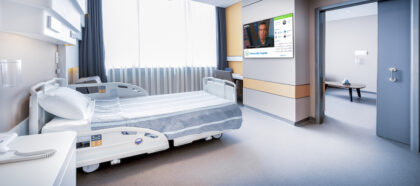Several months ago, my neighbor hired a running coach. With a 10-mile race on the horizon, she wanted the coach’s help going from a runner who finishes distance races strong to a runner who finishes fast. And she succeeded — for the first nine-and-a-half miles of the race. Running a full minute per mile faster, it turned out, was more than her hamstring could handle.
The injury didn’t require surgery, but getting back to being a runner who finishes strong required extensive physical therapy. PT, however, takes time — getting there, being away from home, being away from work, getting back. Knowing this, my neighbor’s insurer never offered the option of in-person PT. Instead, a small tablet and stand arrived in the mail, preloaded with all the exercises she needed to do. The device even tracked her movements, making a pleasant ring each time she performed an exercise correctly.
Several weeks later, when she was feeling better and able to run again, she simply mailed back the device. Although this option isn’t perfect for everyone, for many people — and for providers, especially when patients’ injuries have required surgery — it’s more cost-effective and can also result in better outcomes.
The new recovery model: patient care beyond the four walls of a doctor’s office
For patients recovering from surgery — whether it’s a knee replacement, ACL reconstruction, or rotator cuff repair — post-surgical rehab is critical to regaining strength, mobility, and confidence. But getting to a rehab facility is time-consuming, and in-person care is costly, which leads some patients to skip or delay sessions. That, in turn, increases the risk of reinjury or other complications.
That’s why technology isn’t just more convenient and cost-effective — it can be central to achieving better long-term results.
The advantage of smart devices like tablets is that these connected post-surgical rehab tools give patients structure, accountability, and personalized feedback. As patients perform prescribed exercises, the devices’ sensors track motion, measure range, and ensure movements are done correctly. They also offer guided routines and video demos. And it works: Patients recovering from ACL reconstruction who performed their post-surgical rehab program three to five times each week had significantly improved function one year later and a reduced risk of future injury.
A company that provides virtual rehab and pain-management care through an app that uses AI to track motion, found in a 2022 study that it can save nearly $2,400 per patient annually through a combination of avoided procedures, tests, in-person PT, imaging and other expenses.1 The general PT market is projected to double in size over the next decade to $49 billion, with home health and telehealth comprising a significant portion. And largely due to the cost and time savings, patients tend to prefer virtual rehab care and are more likely to use it.
Interoperability: the hidden key to better recovery
One of the most powerful enablers of this new model is interoperability — the ability of different healthcare technologies and systems to share and use patient data seamlessly. When a tablet-based rehab program can share progress metrics directly with a surgeon’s EHR system, or when data from a wearable device integrates into a physical therapist’s dashboard, care becomes more coordinated and responsive.
For example, a patient’s daily step count, pain levels, and sleep quality — captured by a smartwatch — can be automatically synced with their care team’s platform. This allows providers to adjust exercise intensity, recommend rest periods, or flag potential setbacks before they become serious. Interoperability ensures that no matter where data originates, it can inform better decisions.
A more personalized, patient-driven approach
Device-based care doesn’t just cut costs; it also empowers patients to take more control of their recovery without compromising care quality.
Patients can complete their post-surgical rehab on their own schedules, while receiving frequent feedback that keeps them motivated and reduces setbacks. Providers gain richer, real-time data to personalize treatment timelines and make more informed clinical decisions.
Wearable devices add another layer of insight by tracking improvements in mobility through increased daily steps, monitoring heart rate during exercise, and even recording better sleep patterns as post-operative pain decreases. This continuous stream of data not only helps patients see their own progress, but also gives providers the ability to fine-tune recovery plans in real time.
Mailing patients tablets or directing them to AI-enabled apps is only the beginning. Current trends point toward AI for adaptive post-surgical rehab plans, vastly improved real-time motion capture, remote coaching, and fully wearable-supported recovery pathways.
At-home post-surgical rehab has already transformed from a backup plan into a best practice. The only question is how much farther technology — and the interoperability that connects it all — can take us toward making recovery faster, safer, and more patient-centric.
Explore how to improve the patient experience and outcomes with Samsung’s full range of digital health solutions.
1Hinge Health, “Digital musculoskeletal impact on medical claims: 136 employer study,” September 2022.







